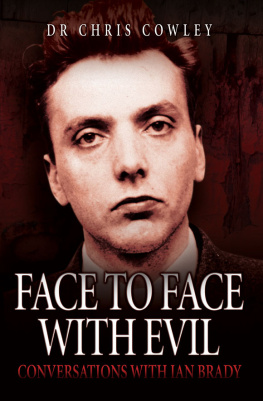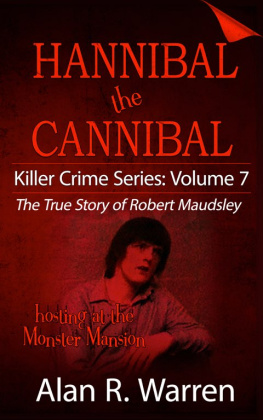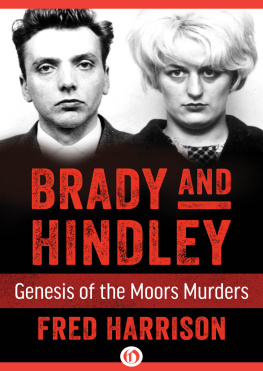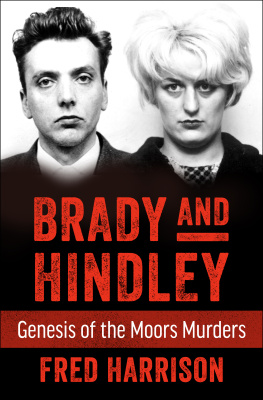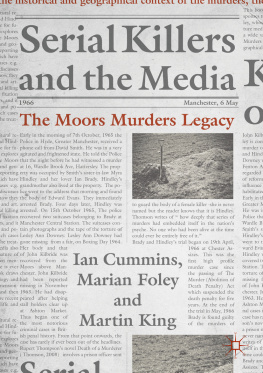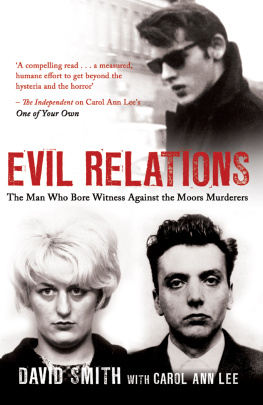
DEDICATION
I would like to dedicate this book to my father, Ken, who has been a constant support and supplied me with many rare resource materials; also to Michelle and the editorial team at John Blake Publishing who kept me focused, and to my friend Rich for his practical help and ongoing positive influence.
CONTENTS
AUTHORS NOTE : All italic quotations, unless otherwise referenced, are directly transcribed from interviews and letters exchanged with Ian Brady (dated when relevant). Quotations from published literature are acknowledged and dated in the authordate format e.g. (Norris 1990) which the reader may then follow up by referring to the reference section at the end. There is also further reading in the Bibliography.
C riminal-profiling techniques that have been designed to identify and apprehend the perpetrators of serial homicide have almost always been based on a retrospective analysis of evidence gathered from crime scenes. In almost all cases, the development of a profile occurs during the investigation of crimes that have already been committed, after the event. Furthermore, profiles are often developed after the perpetrator has been apprehended. While this might offer some insight as to the factors that might need to be considered in future cases, this is obviously rather too late for the people who have already become victims.
The use of criminal profiling as a pre-emptive preventative measure has been under-researched. In cases of potential serial killers, these people need to be identified and apprehended before they embark on a cycle of murders. But is this actually possible?
From comprehensive analysis of case studies, various predictors have been proposed that might enable us to identify potential serial killers and rapists.
Here are some of the most common factors that have been suggested in forensic psychology and criminology research as being possible relevant predictors of serial homicide:
neurophysiological factors, e.g. genetic brain abnormalities;
traumatic brain injuries, especially if there is a repeated history;
psychological factors, especially anger/retaliatory behavioural dispositions;
history of reactive/aggressive responses to negative life events;
posttraumatic-stress disorders;
parental deprivation during critical stages of early psychological development;
history of cruelty to animals;
chronic malnutrition;
chronic drug/alcohol abuse.
This is by no means a conclusive list. Some of these do indeed come up regularly in the case profiles of a number of serial killers, but there are a lot of people who have a significant number of these factors in their histories who do not end up committing serial homicide, and there are also a lot of serial killers who show no history of any of them.
While lecturing as a general cognitive/behaviourist psychologist, my research interests began to gravitate towards criminological history and the psychology of forensic behavioural analysis. For the purposes of this book, this research was refined in order to develop an analysis of the dynamics and consequences of serial murder. My aim was not only to study the perspectives and psychology of people who kill, why they do it and what happens to them after they are caught, but also, where possible, to gather some insight concerning the victims. Without victims, obviously, murder cycles would not and could not happen. Most victims of serial killers are strangers, randomly selected by the killer; the victim simply completes the equation. There are some rare cases, however, in which the victim plays an active part in their destruction. It was important to include research in this area if I wanted to develop an integrated picture of the full dynamics of modern serial homicide.
Understandably, but not terribly scientifically, people looking for answers in their search to identify serial killers are searching for a single explanatory factor. Something that absolutely guarantees that an individual is going to commit capital crimes. An X factor that, if it could be identified, would allow us to say with confidence that that is the catalyst that will start a murder cycle. The hunt for this elusive factor, I believe, is a nonstarter. There are as many reasons for such crimes as there are people committing them. With all case histories, we can see a multitude of potential triggers, and, even if by some miracle we did manage to identify this mysterious catalyst before any murders were committed, how would we proceed then? Locking up individuals before they have killed because we think we know they are going to reeks of an Orwellian precrime law-enforcement nightmare which I hope I will never have to bear witness to. However, I believe that it is possible to identify and examine contributing factors using a multidisciplinary approach that will allow us to say with a certain degree of confidence this it is possible that an individual could be heading towards a serial-murder cycle. This will enable us, hopefully, to provide appropriate intervention and, just maybe, save some lives.
Many of the contributing factors to serial murder are discussed in this book. My own opinions as to their relative strengths and weaknesses will become apparent as you read. I make no claims to offer a definitive solution but perhaps can provide a starting point towards understanding the ever-escalating rise of serial crime.
Once serial killers have been captured and convicted, we have a whole new set of problems to address, the first being: What should we do with them? Many convicted serial killers in America and the Eastern world are executed, and this will certainly stop those particular individuals from killing again (although this is not always true, as I explain later). However, by executing them, we are eliminating opportunities to develop understanding and are effectively burying our heads in the sand while more and more killers emerge to destroy innocent lives. If we shoot the messenger, we are unlikely to find out what the message was.
After a number of years of careful negotiations, I managed to develop the opportunity to conduct a series of interviews and interactions with Ian Stewart Brady, the infamous Moors Murderer. I knew I would be unlikely to get a chance like this again, so, no matter how problematic the research might be, it seemed essential for me to try. This is the central theme of this book. What such people can tell us is, I believe, very important. How could it not be?
PART I
CHAPTER ONE
T he multiple killing of strangers is now unfortunately something of a frequent occurrence in contemporary society. Despite some notable exceptions, this was not always the case. Other than some incidents of religious persecution and political assassinations, in previous centuries serious crime within the general population was nearly always committed for monetary gain, quite literally to put food on the table or to gain the upper hand in war scenarios. Murder, when it happened within the general population who were not involved in fighting a war, was usually a peripheral by-product of robbery in order to eliminate witnesses. Killing was simply a matter of survival. Violent sex crimes were very rare. Rape was pointless because sex could be easily and cheaply obtained.
Blue-collar crimes were occasionally conducted because of greed or revenge, but more often than not they were simply a matter of necessity brought on by poverty and desperation. Rarely were they the product of obsession or homicidal sexual expression. Unusual or enigmatic sex murders before the end of the nineteenth century seem to have been conducted mainly by the aristocracy and the privileged sections of society who had the time, the resources and the imagination to develop dark obsessions. It is different now.
Next page
